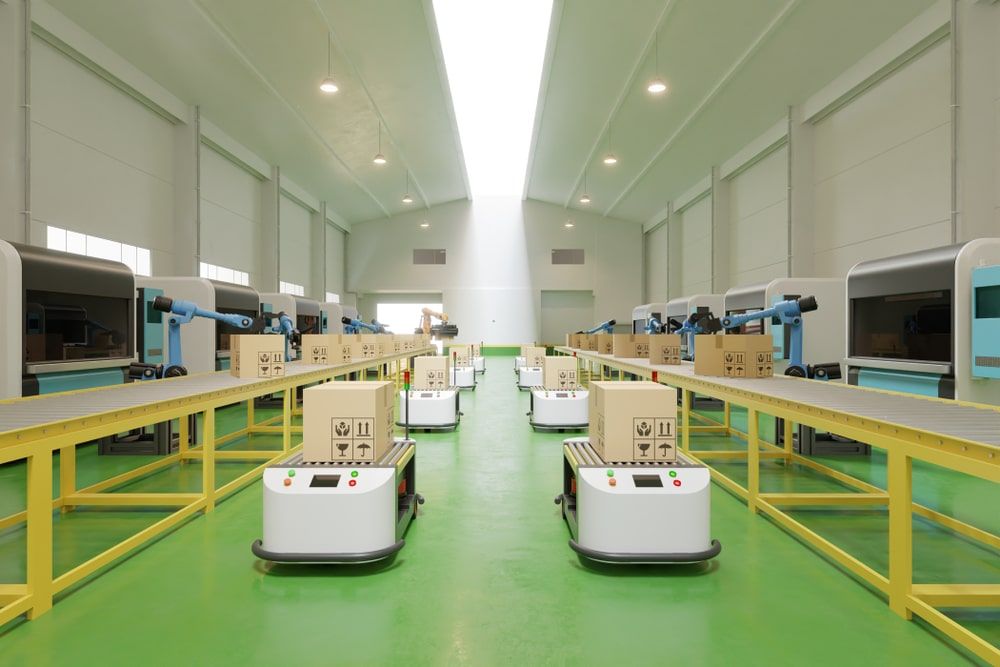Obstacle Avoidance is a robotic science that moves vehicles based on sensory input. Using these techniques instead of conventional ones makes sense when the situation is dynamic and the behavior is unpredictable. A novel technology based on a unique lens architecture is replacing the use of multiple stereo vision obstacle detection sensors or LiDAR to provide 360° situational awareness. Let’s read about trustworthy and secure navigation for autonomous mobile robots.
Combining LiDAR obstacle avoidance with complementary technologies like stereo cameras increases depth sensing and object positioning accuracy and redundancy. More processing capacity is required as a result.
Autonomous Mobile Robots: What are they?
Autonomous Mobile Robots (AMRs) use maps to move around your building, but they only consider stationary or semi-permanent obstacles like walls and shelves. A lot is going on in your warehouse every day that needs to be shown on these maps, including moving pallets and boxes, desks that occasionally shift, and obstacles like forklifts or people. Your Autonomous Mobile Robots (AMRs) must be able to identify all of these risks and safely avoid them reliably.
As more small and medium-sized companies use automation, we see a shift toward more flexible robotics solutions. Systems that generate three-dimensional (3D) visual data are required for applications like item monitoring, automatic bin selection, and product profiling.
Unrestricted by wired power, AMRs use a sophisticated array of obstacle detection sensors, artificial intelligence, machine learning, an obstacle detection camera, and computing for route planning to understand and navigate their environment.
In daily operation, a multi-sensor safety system that feeds data into an advanced planning algorithm that determines whether the robot should adjust its path or come to a safe and immediate stop to avoid collisions ensures the AMRs’ safe driving pattern.
With the help of two lasers, the robot can detect obstacles it can’t maneuver around and safely back up or change direction if necessary. It can also notice people coming up behind or to the side. The SICK microScan 3 is the most recent and cutting-edge laser scanning technology that, the original AMR manufacturer, employs. Since the SICK microScan 3’s laser scanners have ten times greater precision than previous models, the robots are no longer seriously hindered by sunlight and dust, which are typically significant obstacles for the robots to traverse.
The capacity of AMRs to precisely avoid obstacles is one of their more distinctive characteristics. AGV robots use features installed within the facility to navigate, as was covered in this piece about localization. When unidentified elements are introduced, they typically require human involvement because they follow distinct paths and cannot reroute. AMRs employ a more sophisticated obstacle avoidance method, increasing productivity and yielding a better return on investment.
Two 3D sensors for enhanced security
Although many other features are part of the mobile robots’ safe and efficient day-to-day operation, laser scanners are the primary component of the robot’s comprehensive safety and navigation system.
Two 3D sensors mounted on the robot’s front help with navigation by detecting obstacles up to 1,700 millimeters in height. The robot always has a 120° horizontal field of vision, allowing it to see anything. Thus, blocks below or above the safety laser scanners’ field of vision are picked up by the obstacle detection sensor.
As an illustration, this enables the robots to securely maneuver around tables above the field of view of the laser scanner but shorter than the robot’s height, including the top module and load. You can also prevent other obstacles like wall-mounted cabinets or shelves.
Passing Moving Vehicles with Dynamic Obstacle Avoidance
AMRs use limited obstacle avoidance to avoid static obstacles, deviating from their route for only a short distance. While this works in isolated instances, more is needed in crowded places. Industrial areas frequently have moving vehicles, and AMRs are much better suited to handle these interactions.
The laws of the road are known to AMRs. Other AMRs move seamlessly with further objects and entities in their typical space because they are made for sharing space with manually operated vehicles. When an AMR encounters incoming traffic, it can move to the side to pass, wait until all is clear, and then carry out the remainder of its task.
Automated Guided Vehicle Robot LiDAR
The use of robots can be a solution to these issues in situations where it is dangerous for people and their environment. A variety of sensors determines the exact location of the robot and its obstacle-free path.
However, conventional sensors’ detection range, spatial precision, and computational complexity are constrained. This research has created an autonomous mobile robot with a Light Detection and Ranging (LiDAR) sensor to avoid obstacles. The robot’s moves are navigated using the Braitenberg vehicle strategy. On a single Raspberry Pi 3 computer board, an algorithm for collecting sensor data and controlling it is developed.
According to the experimental findings, this sensor can reliably measure distance without being influenced by the object’s color or brightness. The mobile robot is capable of dodging colored items of various sizes. This mobile autonomous robot can move around the room without bumping into any walls or obstacles.
History of Automated Guided Vehicle Robot LiDAR
The automated guided vehicle (AGV) was first used for transportation in the UK in 1953. However, they are now used in various industrial uses due to their high efficiency, flexibility, reliability, safety, and system scalability. In a nutshell, the automated guided vehicle robot LiDAR system comprises a vehicle chassis, an embedded processor, motors, drivers, navigation and collision avoidance sensors, a communication device, and a battery. Some even have load transfer devices. In this review paper, the AGV structures are examined and compared from different angles based on existing systems, and an analysis of the AGV structure is done for designers.
AMR Collision Avoidance vs. Obstacle Avoidance
Both AMRs and AGVs have accident-avoidance capabilities. At a minimum, their safety mechanism will detect any obstruction and safely slow or stop the robot before a collision happens. However, the powers of AGVs usually end here. On the other side, AMRs can avoid obstacles. The robot can reroute and carry out its job as a person would, in addition to being able to avoid collisions.
Obstacle avoidance is essential in a dynamic warehouse setting. AGVs must be monitored more frequently if they only have rudimentary collision avoidance. Any obstruction will require a person to relocate it, such as trashed packaging or another vehicle. These frequent interruptions take up employees’ time and waste labor resources that could be used in other ways. This degree of contact essentially defeats the original intent behind integrating warehouse robots.
AMRs are much more capable of achieving absolute autonomy. They can solve issues independently and consistently contribute value because they don’t impede other workflows.
Traffic Congestion with AMR and AGV Robots
All mobile robots possess what is known as safety fields, or speed-restricted zones, and the ability to recognize an obstruction and prevent a collision. Robots are programmed to slow down or halt in these places and wait a predetermined amount before continuing their work. During the mapping procedure, AGV vendors program these places into the robots.
However, it’s essential to stress once more that depots are dynamic settings. When the AGV was installed, a space that wasn’t being used could end up being the facility’s busiest hub, while the previously high-traffic area was left vacant. One of two approaches could be used to manage this:
- First, the AGV might sense traffic and slow down in the freshly busy area while also unnecessarily continuing its programmed slowdown in the original, empty space. It could improve the effectiveness of the cars.
- Second, the AGV might be programmed to plow through the formerly empty but now heavily traveled region. Major safety concerns arise from this.
AMRs’ capabilities for path planning provide a solution to this issue by adjusting both speed and orientation. Robots with this technology use intelligent analytics to select the fastest path to complete their job, considering traffic and obstacles in real time. AMRs can momentarily deviate from the path to navigate around traffic at a safe distance. In contrast, AGVs are constrained to waiting until their way is clear, leaving plenty of space for other actors to finish their tasks. AMRs will select a different path if there are more effective options.
Advantages of Autonomous Mobile Robots LiDAR over Automated Guided Vehicle Robot LiDAR
Most dynamic warehouse settings have fast-moving inventory and frequently changing floor plans or workflows. A path that follows an AGV cannot adapt to these shifts. A site manager must physically reroute the automated guided vehicle robot LiDAR to teach it a new way. These interruptions take up time from the employees. AMRs successfully escape obstacles while offering unparalleled autonomy. They are much better equipped to work independently, providing floor managers peace of mind and enabling optimized, independent workflows.
The application of obstacle avoidance technology by autonomous mobile robots—such as self-driving tuggers, fork trucks, and pallet trucks—maximizes productivity and safety.
To sum up:
Mobile robots now have situational awareness thanks to this sensor technology, enabling them to work with humans on challenging tasks. Although many different methods exist, you won’t see them on a robot nearby. Most autonomous robotic systems can move and perform tasks automatically based on the environment, thanks to a combination of the obstacle detection sensor, as mentioned earlier.





